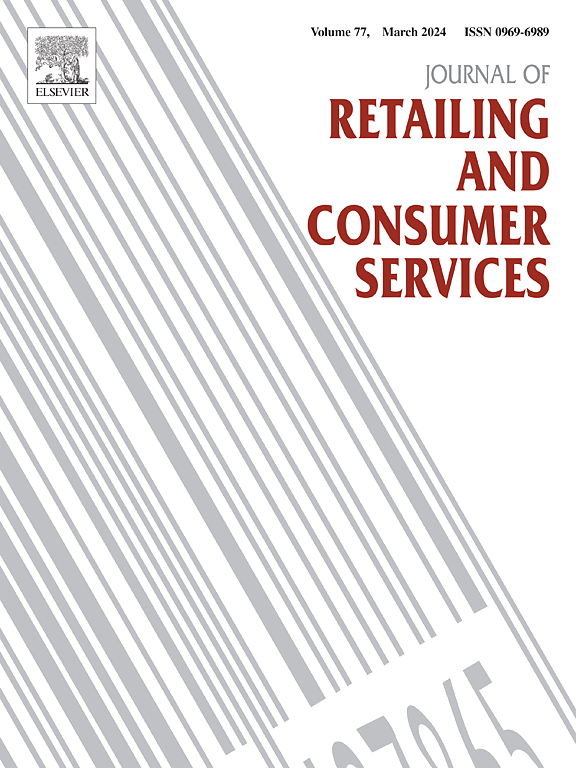在会话建议中裁剪解释:决策上下文和用户界面的影响
IF 11
1区 管理学
Q1 BUSINESS
Journal of Retailing and Consumer Services
Pub Date : 2025-03-05
DOI:10.1016/j.jretconser.2025.104281
引用次数: 0
摘要
可解释性对于在传统推荐系统中建立信任至关重要,但其在会话设置中的作用尚未得到充分探讨。在三项实验研究(N = 1429)中,我们使用了不同产品类别(相机、智能手表、耳机)的受试者间设计,以检验事后解释(基于专家验证vs基于共识验证)和决策领域(享乐主义vs功利主义)对消费者对会话推荐反应的互动影响。我们进一步研究了消费者决策风格(直觉vs理性)和用户界面(基于文本vs基于语音)如何调节这些影响。结果表明,事后解释提高了感知的透明度和可解释性,从而增加了消费者对会话推荐的信任。在基于文本的界面中,做出享乐主义决策的消费者更倾向于基于共识的解释,而对于功利主义决策者则没有明显的偏好。在基于语音的界面中,功利主义的消费者更喜欢基于共识的解释,而对享乐主义的决定没有明显的偏好。此外,直觉型消费者更倾向于基于共识的享乐决策解释和基于专家的功利决策解释。理性的消费者在两个决策领域都一贯支持基于共识的解释。这些发现为在电子商务平台上设计会话推荐系统提供了有价值的见解。通过调整对决策领域、用户界面和消费者决策风格的解释,企业可以培养更大的信任和参与,推动更有利的购买行为并改善业务成果。本文章由计算机程序翻译,如有差异,请以英文原文为准。
Tailoring explanations in conversational recommendations: The impact of decision contexts and user interfaces
Explainability is crucial for building trust in traditional recommendation systems, yet its role in conversational settings is underexplored. Across three experimental studies (N = 1,429), we used between-subjects designs featuring diverse product categories (cameras, smartwatches, headphones) to examine the interactive effects of post hoc explanations (expert validation-based vs. consensus validation-based) and decision-making domains (hedonic vs. utilitarian) on consumer responses to conversational recommendations. We further examined how consumer decision-making styles (intuitive vs. rational) and user interfaces (text-based vs. voice-based) moderated these effects. Results show that post hoc explanations enhance perceived transparency and interpretability, thereby increasing consumer trust in conversational recommendations. In text-based interfaces, consumers making hedonic decisions preferred consensus-based explanations, whereas no clear preference emerged for utilitarian decision-makers. In voice-based interfaces, utilitarian consumers favored consensus-based explanations, while no significant preference was observed for hedonic decisions. Furthermore, intuitive consumers preferred consensus-based explanations for hedonic decisions and expert-based explanations for utilitarian decisions. Rational consumers consistently favored consensus-based explanations across both decision-making domains. These findings provide valuable insights for designing conversational recommendation systems on e-commerce platforms. By tailoring explanations to decision domains, user interfaces, and consumer decision-making styles, businesses can foster greater trust and engagement, driving more favorable purchasing behaviors and improving business outcomes.
求助全文
通过发布文献求助,成功后即可免费获取论文全文。
去求助
来源期刊
CiteScore
20.40
自引率
14.40%
发文量
340
审稿时长
20 days
期刊介绍:
The Journal of Retailing and Consumer Services is a prominent publication that serves as a platform for international and interdisciplinary research and discussions in the constantly evolving fields of retailing and services studies. With a specific emphasis on consumer behavior and policy and managerial decisions, the journal aims to foster contributions from academics encompassing diverse disciplines. The primary areas covered by the journal are:
Retailing and the sale of goods
The provision of consumer services, including transportation, tourism, and leisure.

 求助内容:
求助内容: 应助结果提醒方式:
应助结果提醒方式:


